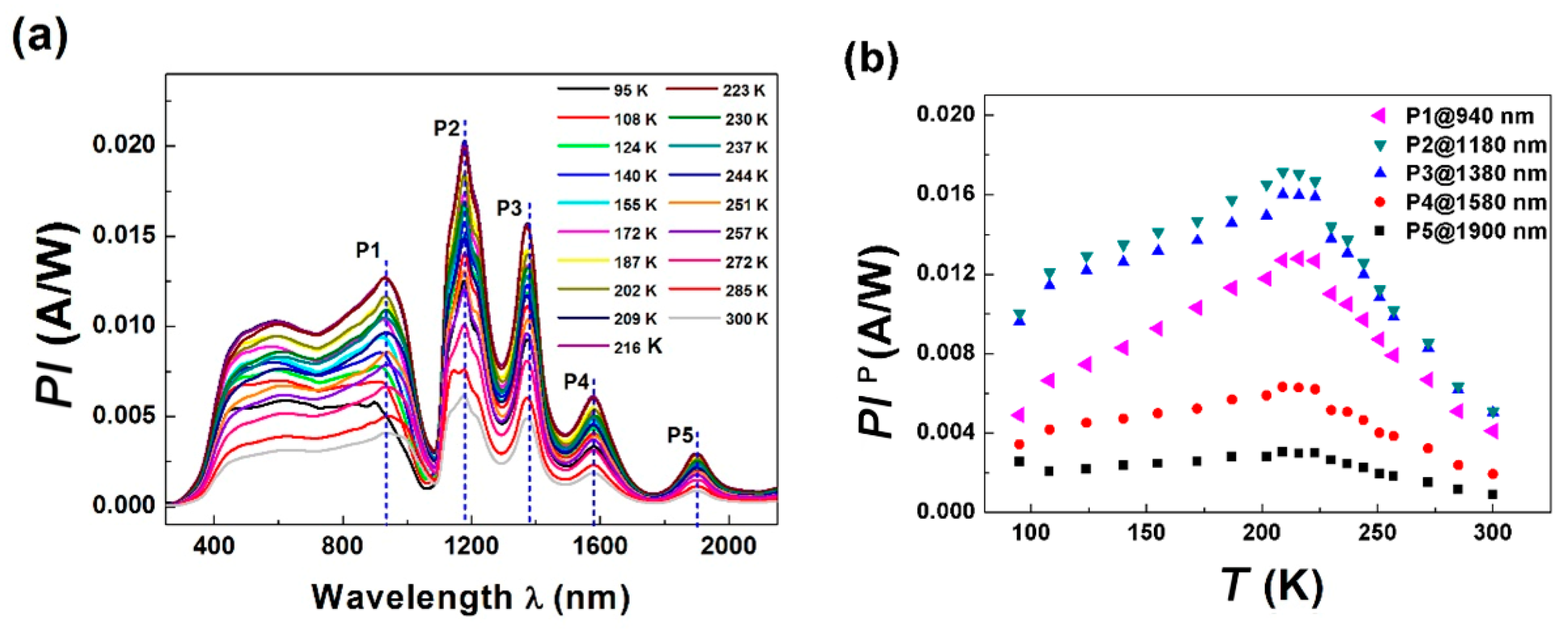Manganite Heterojunction Photodetector with Broad Spectral Response Range from 200 nm to 2 μm
Abstract
:1. Introduction
2. Materials and Methods
3. Results and Discussions
4. Conclusions
Author Contributions
Funding
Acknowledgments
Conflicts of Interest
References
- Jin, K.J.; Lu, H.B.; Zhao, K.; Ge, C.; He, M.; Yang, G.Z. Novel multifunctional properties induced by interface effects in perovskite oxide heterostructures. Adv. Mater. 2009, 21, 4636–4640. [Google Scholar] [CrossRef]
- Lu, Z.Q.; Ni, H.; Zhao, K.; Leng, W.X.; Kong, Y.C.; Wong, H.K. Fast photovoltaic effects tuned by vicinal interface microstructure in manganite-based all-perovskite-oxide heterojunctions. Appl. Opt. 2011, 50, G23–G26. [Google Scholar] [CrossRef] [PubMed]
- Jin, K.J.; Zhao, K.; Lu, H.B.; Liao, L.; Yang, G.Z. Dember effect induced photovoltage in perovskite p-n heterojunctions. Appl. Phys. Lett. 2007, 91. [Google Scholar] [CrossRef]
- Li, X.M.; Zhao, K.; Ni, H.; Zhao, S.Q.; Xiang, W.F.; Lu, Z.Q.; Yue, Z.J.; Wang, F.; Kong, Y.C.; Wong, H.K. Voltage tunable photodetecting properties of La0.4Ca0.6MnO3 films grown on miscut LaSrAlO4 substrates. Appl. Phys. Lett. 2010, 97. [Google Scholar] [CrossRef]
- Ni, H.; Zhao, K.; Xi, J.F.; Feng, X.; Xiang, W.F.; Zhao, S.Q.; Kong, Y.C.; Wong, H.K. Current-pulse-induced enhancement of transient photodetective effect in tilted manganite film. Opt. Express 2012, 20, 28494–28499. [Google Scholar] [CrossRef]
- Ni, H.; Yue, Z.; Zhao, K.; Xiang, W.F.; Zhao, S.Q.; Wang, A.J.; Kong, Y.C.; Wong, H.K. Magnetical and electrical tuning of transient photovoltaic effects in manganite-based heterojunctions. Opt. Express 2012, 20, A406–A411. [Google Scholar] [CrossRef]
- Ni, H.; Zhao, K.; Jin, K.J.; Kong, Y.C.; Wong, H.K.; Xiang, W.F.; Zhao, S.Q.; Zhong, S.X. Nano-domain orientation modulation of photoresponse based on anisotropic transport in manganite films. Eur. Lett. 2012, 97, 46005. [Google Scholar] [CrossRef] [Green Version]
- Zhao, S.S.; Ni, H.; Zhao, K.; Kong, Y.C.; Wong, H.K.; Zhao, S.Q.; Xiang, W.F. Laser induced photovoltaic effects in manganite films for high temperature photodetecting applications in oil and gas optics. Opt. Commun. 2013, 288, 72–75. [Google Scholar] [CrossRef]
- Zhao, S.S.; Ni, H.; Zhao, K.; Xiang, W.F.; Zhao, S.Q.; Kong, Y.C.; Wong, H.K. Manganite heterojunction photodetectors for femtosecond pulse laser measurements. Opt. Laser Technol. 2012, 44, 1758–1761. [Google Scholar] [CrossRef]
- Zhao, S.S.; Ni, H.; Zhao, K.; Zhao, S.Q.; Kong, Y.C.; Wong, H.K. High-sensitivity photovoltaic responses in manganite-based heterojunctions on Si substrates for weak light detection. Appl. Opt. 2011, 50, 2666–2670. [Google Scholar] [CrossRef]
- Ni, H.; Da, S.L.; Zhao, K.; Kong, Y.C.; Wong, H.K.; Zhao, S.Q. Temperature-dependent transport and transient photovoltaic properties of La2/3Ca1/3MnO3/Nb:SrTiO3 heteroepitaxial p-n junction. J. Appl. Phys. 2012, 112, 023101. [Google Scholar] [CrossRef]
- Ni, H.; Da, S.L.; Zhao, K.; Kong, Y.C.; Wong, H.K.; Zhao, S.Q. Transport and transient photovoltaic properties of La0.4Ca0.6MnO3/Nb:SrTiO3 heterojunction at high temperature. Appl. Phys. A Mater. Sci. Process. 2012, 108, 645–649. [Google Scholar] [CrossRef]
- Liu, H.; Zhao, K.; Zhou, N.; Lu, H.B.; He, M.; Huang, Y.H.; Jin, K.J.; Zhou, Y.L.; Yang, G.Z.; Zhao, S.Q.; et al. Photovoltaic effect in micrometer-thick perovskite-type multilayers on Si substrates. Appl. Phys. Lett. 2008, 93, 171911. [Google Scholar] [CrossRef]
- Zhou, N.; Zhao, K.; Liu, H.; Lu, H.B.; He, M.; Zhao, S.Q.; Leng, W.X.; Wang, A.J.; Huang, Y.H.; Jin, K.J.; et al. Enhanced photovoltage in perovskite-type artificial superlattices on Si substrates. J. Phys. D Appl. Phys. 2008, 41, 155414. [Google Scholar] [CrossRef] [Green Version]
- Du, J.; Ni, H.; Zhao, K.; Kong, Y.C.; Wong, H.K.; Zhao, S.Q.; Chen, S.H. Enhanced lateral photovoltaic effect in the p-n heterojunction composed of manganite and silicon by side irradiation for position sensitive detecting. Opt. Express 2011, 19, 17260–17266. [Google Scholar] [CrossRef]
- Okimoto, Y.; Katsufuji, T.; Ishikawa, T.; Urushibara, A.; Arima, T.; Tokura, Y. Anomalous variation of optical spectra with spin polarization in double-exchange ferromagnet: La1-xSrxMnO3. Phys. Rev. Lett. 1995, 75, 109–112. [Google Scholar] [CrossRef]
- Kim, K.H.; Gu, J.Y.; Choi, H.S.; Park, G.W.; Noh, T.W. Frequency shifts of the internal phonon modes in La0.7Ca0.3MnO3. Phys. Rev. Lett. 1996, 77, 1877–1880. [Google Scholar] [CrossRef]
- Kaplan, S.G.; Quijada, M.; Drew, H.D.; Tanner, D.B.; Xiong, G.C.; Ramesh, R.; Kwon, C.; Venkatesan, T. Optical evidence for the dynamic Jahn-Teller effect in Nd0.7Sr0.3MnO3. Phys. Rev. Lett. 1996, 77, 2081–2084. [Google Scholar] [CrossRef]
- Calvani, P.; Marzi, G.D.; Dore, P.; Lupi, S.; Maselli, P.; D’Amore, F.; Gagliardi, S.; Cheong, S.W. Infrared absorption from charge density waves in magnetic manganites. Phys. Rev. Lett. 1998, 81, 4504–4507. [Google Scholar] [CrossRef]
- Kim, K.H.; Jung, J.H.; Eom, D.J.; Noh, T.W.; Yu, J.; Choi, E.J. Scaling Behavior of spectral weight changes in perovskite manganites La0.72-yPryCa0.3MnO3. Phys. Rev. Lett. 1998, 81, 4983–4986. [Google Scholar] [CrossRef] [Green Version]
- Sacchetti, A.; Guidi, M.C.; Arcangeletti, E.; Nucara, A.; Calvani, P.; Piccinini, M.; Marcelli, A.; Postorino, P. Far-infrared absorption of La1-xCaxMnO3-y at high pressure. Phys. Rev. Lett. 2006, 96, 035503. [Google Scholar] [CrossRef] [PubMed]
- Pakhira, N.; Krishnamurthy, H.R.; Ramakrishnan, T.V. Optical conductivity of perovskite manganites. Phys. Rev. B 2011, 84, 085115. [Google Scholar] [CrossRef]
- Yue, Z.J.; Zhao, K.; Ni, H.; Zhao, S.Q.; Kong, Y.C.; Wong, H.K.; Wang, A.J. Photo-induced magnetoresistance enhancement in manganite heterojunction at room temperature. J. Phys. D Appl. Phys. 2011, 44, 095103. [Google Scholar] [CrossRef]




© 2020 by the authors. Licensee MDPI, Basel, Switzerland. This article is an open access article distributed under the terms and conditions of the Creative Commons Attribution (CC BY) license (http://creativecommons.org/licenses/by/4.0/).
Share and Cite
Chen, R.; Lu, Z.; Zhao, K. Manganite Heterojunction Photodetector with Broad Spectral Response Range from 200 nm to 2 μm. Micromachines 2020, 11, 129. https://doi.org/10.3390/mi11020129
Chen R, Lu Z, Zhao K. Manganite Heterojunction Photodetector with Broad Spectral Response Range from 200 nm to 2 μm. Micromachines. 2020; 11(2):129. https://doi.org/10.3390/mi11020129
Chicago/Turabian StyleChen, Ru, Zhiqing Lu, and Kun Zhao. 2020. "Manganite Heterojunction Photodetector with Broad Spectral Response Range from 200 nm to 2 μm" Micromachines 11, no. 2: 129. https://doi.org/10.3390/mi11020129




